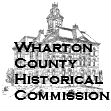Wharton County was created in 1846, incorporating part of Stephen F. Austin’s original land grant from Mexico. The William Kincheloe family donated land on the east side of the Colorado River for a courthouse square; the home of son Daniel Kincheloe actually served as the first, temporary courthouse. A frame building (1848) and two-story building (1852) served until the new edifice was constructed in the 1880’s. Judge Wylie J. Croom favored a new building, while A. H. “Shanghai” Pierce tried to prevent that from happening by securing an injunction to stop the county from proceeding.
In 1888 county commissioners ordered drawings from noted Texas architect Eugene T. Heiner for a new courthouse and jail. Heiner, a founding member of Texas State Association of Architects, also designed Judge Croom’s home (1895), Wharton Public School (1899), and many other commercial and public buildings in Texas. Completed in 1899, the courthouse’s salmon-colored clay came from Colorado River clay deposits.
In 2004, after years of controversy and debate, work was begun toward restoration of the courthouse, with completion in the summer of 2007. The entire project is a very long and detailed story, best told during courthouse tours by one of the restoration committee members, Jeffrey Blair. The sequence of events is detailed in Julie Freeman Reid’s Master’s Thesis Dissertation titled Up She Rises: The Birth and Legacy of the Texas Historic Courthouse Preservation Program, “A Tale of Two Courthouses,” 2015. Former Wharton County Historical Commission Chairman A. C. Shelton took literally thousands of photos of the various stages as they occurred, from steadying the foundation, to the discovery of cresting under the gazebo, to placement of the clock tower, and many more.
(Some of the above text was taken from the National Register application, found on this website under National Register properties.)

